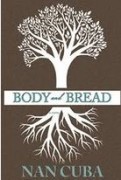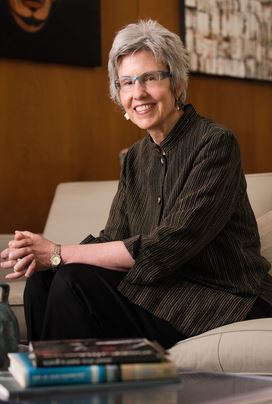Like every person, every family contains contradictions, oppositions. Think of the generally quiet, sober couple who produce a jokester or chatterbox. Or the child who in church looks past her brothers’ and sisters’ bowed heads, searching for fellow doubters. Such contradictions may develop into deep conflicts or become a source of wonder, even pride. Either way, they can be a powerful force; that’s just one truth examined in Nan Cuba’s sweeping, carefully observed début novel, Body and Bread.
At the heart of the novel is the relationship between Sarah Pelton and her brother Sam, whose suicide, in his mid-twenties, changes the course of Sarah’s life. Through flashbacks, we see Sarah and Sam coming of age in the fictional town of Nugent, Texas, in the late fifties to early seventies. Unlike the other Peltons, they seem driven to make a break from family expectations and traditions. The family patriarch, Owen, is a man who, in Sam’s words, has a “rulebook in his head. … Whatever’s left out of that rulebook might as well not exist.” The oldest Pelton brother, Kurt, and the youngest one, Hugh, seem determined to follow their father’s rules and his path to careers in medicine. Sam, however, charts a dramatically different course. As Cuba writes, “Sam’s otherness was tied to ‘unacceptable’ habits like telling what he honestly thought, remarks others labeled ‘disrespectful,’ while he called them truths.”
For Sam, the truths lie in the physical world, and Cuba presents this world in sharp detail, from Sam’s point of view: “He loved death or sex or any secret topic, the same way he ate a farm peach: examining the stem hole, skin fuzz, coloration; savoring pulp, nectar; finally sucking the pit, knotty and wooden. Any less fervor was, for him, a sacrilege.”
In efforts to introduce Sarah to some of the secret, physical truths of the world, thirteen-year-old Sam guts a fish in front of nine-year-old Sarah so that the two of them can explore the creature’s insides. When they are older, he takes her into the lab where their father teaches anatomy and shows her a cadaver. Here, Sarah is “embarrassed but determined to watch whatever Sam might do. If the men in my family could look at a naked, plucked, dead man, so could I.”
Like Sam, Sarah doesn’t want to be restricted by her father’s rulebook, but the truths she seeks are more spiritual than physical. In her first attempt to rebel against her parents’ “prefabricated life,” Sarah tries to ritually honor Tlahzolteotl, an Aztec goddess and the “[p]atroness of adulterers and physicians.” By stoking a ceremonial fire in a restored steam engine, she nearly kills herself and two friends. Afterward, Sarah chooses “what seemed to be the safer path: religion.” She starts down this path when a young man introduces her to a Christian organization, the School of Jericho Prophets. But even this “safer” action is a form of rebellion, for in the eyes of Sarah’s mother, the organization is a cult.
Cuba has a gift for describing youthful experimentation and all the discomfort, awkwardness, and amazement that can go with it. Sarah’s chosen experiments—even the potentially fatal Aztec ritual—are also funny. When she first sees Elijah, the prophet behind the School of Jericho, she thinks, “His appearance seriously tested my composure. … He was tall, brawny, a fullback in a toga.” After being introduced to Elijah, Sarah is no more at ease:
“Wherever you go, my dear, may your spirit, like leaven in dough, shape you into good light bread.” He rubbed the sign of a cross on my forehead then walked toward a home-school display.
As Sarah grows more involved with the School of Jericho Prophets, Sam begins a steep mental and emotional decline that threatens his personal relationships, including his marriage to Terezie Cervenka, the daughter of tenant farmers on the Peltons’ land. Not long after a car accident leaves Sam a paraplegic, Sarah breaks with the School to devote more time to him. But not even she can prevent his suicide, and its effects on her are lasting.
After losing Sam, Sarah retreats deeply into the life of the mind, becoming an anthropologist who specializes in pre-Columbian culture, and interacting with others only when her teaching or other responsibilities require her to. She applies her skills as an anthropologist to take a closer look at her family’s past and to try to learn more about why Sam committed suicide. In the process, she uncovers a secret that gives her a new perspective on him and her family.
Through her descriptions of Sarah’s thoughts and dealings with others, Cuba gives us an understated yet powerful sense of the ongoing impact of Sam’s loss. At one point, Sarah comes to a conclusion that is likely to ring true to others who have faced such a loss: “Suffering can’t be explained or accepted, so I’ll live with questions.” (Sadly, Cuba’s own experience with suicide informed her work on the novel. “My brother Paul took his life,” she told journalist and blogger Ken Rodriguez. “I knew intuitively I was writing about why my brother committed suicide. I wanted readers to see the damage done to people left behind.”)
Another family crisis, this one set in the present, forces Sarah out of her insular world. When she learns that Terezie’s daughter, Cornelia, will die unless she receives a kidney transplant, Sarah reaches out to her surviving brothers, Kurt and Hugh, from whom she’s become estranged. Sarah makes the case that the three of them are obligated to follow wishes expressed in Sam’s suicide note: that all his possessions be transferred to Terezie. To Sarah’s mind, this means that Terezie should receive Sam’s entire share of the proceeds from the Pelton parents’ estate, which would help her pay Cornelia’s medical expenses. But Kurt and Hugh, who have had minimal contact with Terezie since Sam’s death, strongly disagree. As Hugh tells Sarah, “My obligation is to provide for my wife and daughter. God’ll take care of Terezie and Cornelia.”
Cuba realistically portrays the tensions that conflicting financial and personal priorities can cause in families. Moreover, these scenes provide another window into the effects of Sam’s suicide, and into the differences between Sarah and her surviving brothers, which time and the varying courses of their lives have only magnified. One bright spot is the connection Sarah and Cornelia form during this crisis, a connection that remains a source of hope as the novel moves forward.
So much more could be said about what makes this novel worth reading: the way Cuba brings the rural Texas setting to life; the way she touches on Czech settlers’ influence in Texas through the story of Terezie’s family, the Cervenkas; and, most impressive, how Cuba connects Aztec myths and rituals, a longstanding fascination of Sarah’s, to the larger story. According to the Aztec worldview, “Transformation is inevitable, destruction necessary in order to create.” As Sarah learns, she must destroy some of her own family myths to move ahead with her life.
Would My Pick be Your Pick?
If you're interested in ________, the answer may be "Yes":• Historical novels (especially anything related to Texas history)
• Family sagas
• Stories of family conflicts/sibling rivalries
• Coming-of-age stories / authentic descriptions of adolescent and young-adult emotions and experiences
• Insights about how individuals and families cope with trauma
• Anything written by Marilynne Robinson






